
Sunday January 1, 2023
By Denise Chow
It was a year characterized by extreme drought.
From North America to Africa to Europe to Asia, huge swaths of the planet were parched in 2022. Lakes and rivers in several countries shrank to extreme lows and dry conditions threatened crops and fueled destructive wildfires across the globe.
advertisements
As the world warms, climate change will exacerbate drought conditions on the planet. Research has shown that global warming worsens drought by enhancing evaporation, depleting reservoirs and drying out soils and other vegetation.Here’s what drought this year looked like on four of the hardest-hit continents.
Asia
The world’s largest continent provided a dire blueprint in 2022 of the consequences of drought and extreme heat in a warming world.
In March, an early heat wave gripped India and Pakistan, causing at least 90 deaths as temperatures in some spots soared as high as 115 degrees Fahrenheit. The scorching conditions ignited forest fires in India and fueled the rapid melting of glaciers in northern Pakistan, which led to catastrophic flooding and even wiped out a bridge in the country’s Hunza Valley. A study released in May by the World Weather Attribution group found that the punishing heat in India and Pakistan was 30 times more likely due to climate change.
Over the summer, prolonged heat waves in China created severe drought conditions for many parts of the country. Sections of the Yangtze River, the longest river in Asia, reached record low levels in August, with some areas almost completely drying up. Some 400 million people in China depend on the Yangtze River for drinking water and to irrigate rice, wheat and other crops, according to the Nature Conservancy. The waterway is also a major source of hydropower for the country and plays a key role in shipping and global supply chain management.
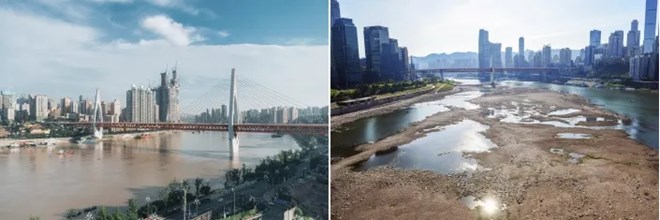
Dongshuimen Bridge in Chongqing, China, on July 17, 2018, left, and August 18, 2022. (Imaginechina via AP Images; VCG via Getty Images)
In the country’s southwestern Sichuan province, the most extreme heat wave and drought in six decades caused water flow to the region’s hydropower reservoirs to plummet in late August, prompting the provincial government to warn of “particularly severe” power outages, the South China Morning Post reported.
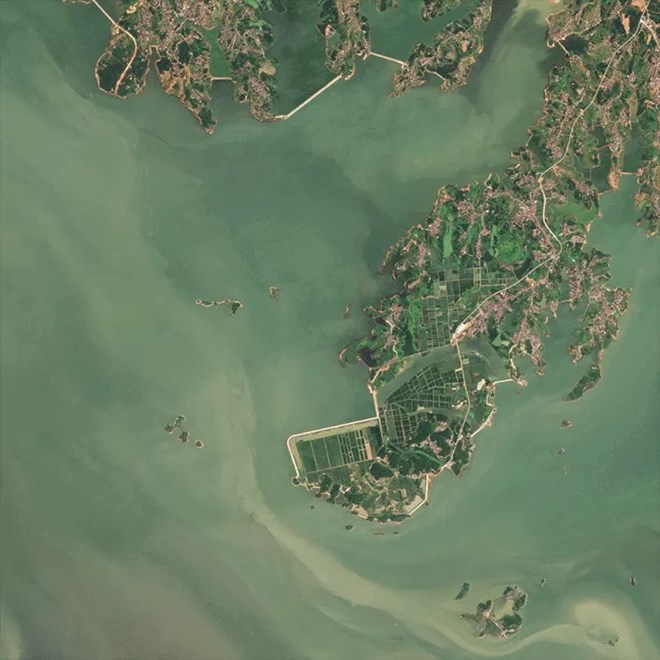
Poyang Lake in Jiangxi, China on Aug. 8, 2021 and Aug. 22, 2022. (Planet Labs PBC)
The following month, September, officials in the central Chinese province of Jiangxi declared a water supply “red alert” for the first time as Poyang Lake’s water levels fell dramatically due to drought. The freshwater lake is the country’s largest and is normally a flood outlet for the Yangtze River.
Drought conditions gripped central China over the summer months, with the Jiangxi province experiencing 60% less precipitation from July to September compared to the same time last year, according to the Jiangxi Water Monitoring Center.
In Anhui province, which neighbors Jiangxi, water levels at 10 reservoirs fell below “dead pool” status, when the reservoir is so low that water cannot flow downstream from the dam.
Africa
The effects of extreme heat and drought were also dire for parts of Africa in 2022.
The Horn of Africa, which encompasses the easternmost part of the continent, experienced its longest drought in 40 years in 2022, according to the World Meteorological Organization (WMO). The region experienced drier than average conditions as it suffered through its fifth consecutive failed rainy season. Humanitarian organizations warned that the prolonged drought is exacerbating food insecurity issues for more than 50 million people in the region.
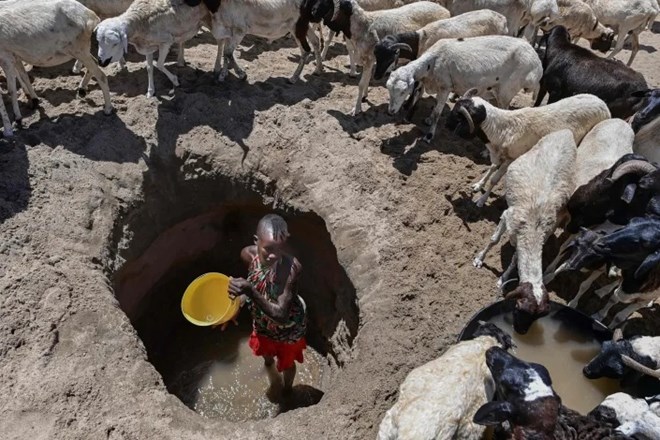
A woman waters goats from a shallow well dug into a dry riverbed at Eliye springs on the western shore of Lake Turkana in Kenya (Tony Karumba / AFP via Getty Images file )
Parts of Kenya, Ethiopia and Somalia were among the hardest hit by drought this year. Guleid Artan, director of the WMO’s climate center for East Africa said in August that the three countries are “on the brink of an unprecedented humanitarian catastrophe” because of rainfall deficits and ongoing drought.
The United Nations said severe drought and food shortages are likely to persist, which could lead to famine in parts of the Horn of Africa.
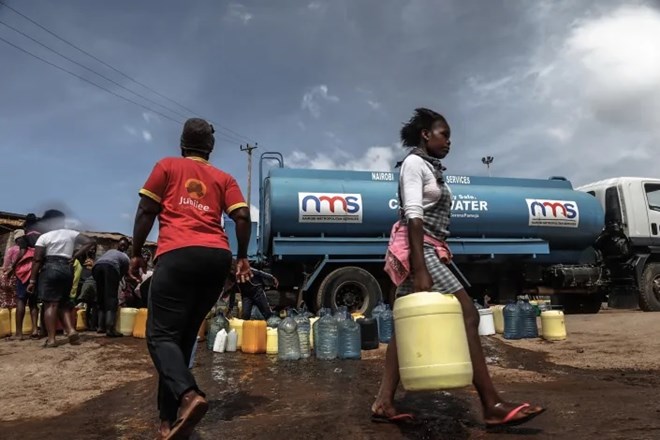
A woman seen carrying her water container filled with water (Donwilson Odhiambo / SOPA Images/LightRocket via Getty Images file )
“Unfortunately, we have not yet seen the worst of this crisis,” Michael Dunford, the U.N. World Food Program’s regional director for eastern Africa, said in a Nov. 28 statement. “If you think 2022 is bad, beware of what is coming in 2023.”
In a report released in October, the United Nations and the Red Cross said certain regions of Africa and Asia will become uninhabitable within decades because of extreme heat.
“The impacts would include large-scale suffering and loss of life, population movements and further entrenched inequality. These impacts are already emerging,” the organizations jointly wrote.
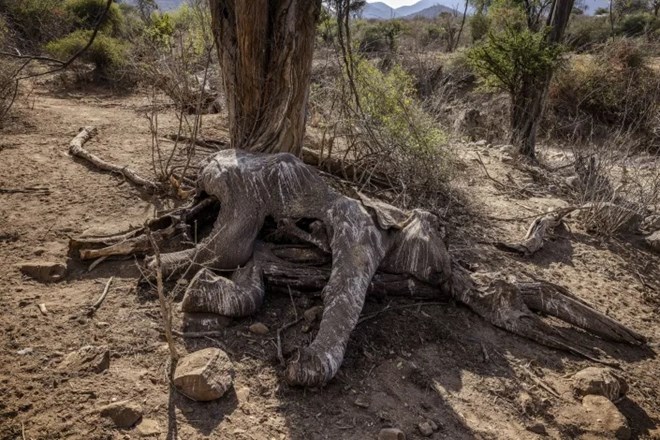
The carcass of an adult elephant, which died during the drought, at the Namunyak Wildlife Conservancy in Samburu, Kenya (Luis Tato / AFP via Getty Images file )
Europe
Elsewhere in the world, conditions were similarly parched this past summer.
A preliminary report released in August by the European Commission found that Europe’s 2022 droughts were the worst in at least 500 years. Many regions were under drought since the beginning of the year, made worse by drier-than-usual conditions over the summer and a series of heat waves from June through October.
In August, almost two-thirds of the European continent was under either drought warning or alert conditions, according to the report. Low rainfall over the summer months and persistent dry conditions added stress to summer crops in parts of Italy, Germany, France, Spain, Portugal and Hungary.
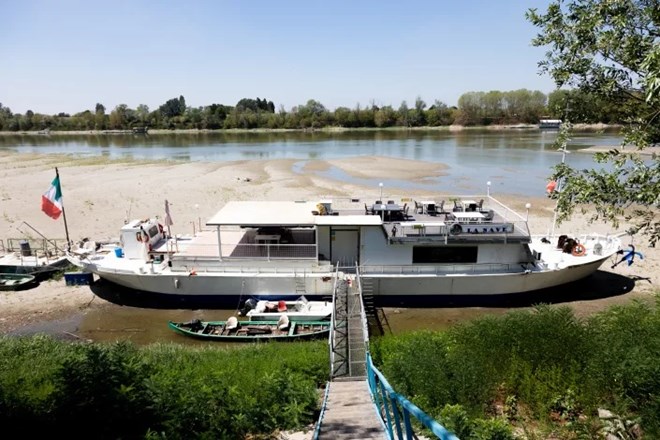
A boat moored on dry waters on the river Po in Ficarolo, Italy, on July 30, 2022. (Nicola Ciancaglini / Ciancaphoto Studio/Getty Images file )
In Italy, rivers and lakes dried up over the summer. Large sections of the country’s longest river, the River Po, ran completely dry, forcing officials in July to declare a state of emergency in five northern regions.
Lake Garda, Italy’s largest lake, also shrank to near-historic lows over the summer. Water from the lake was diverted to local rivers to help farmers across the parched north of the country, leaving Lake Garda 12.6 inches above the water table, which approached the lowest levels recorded in 2003 and 2007.
Waterways elsewhere in Europe were similarly impacted by drought and extreme heat. In August, Serbia’s Danube River shrank to one of its lowest levels in almost a century. The Loire River in France also fell to historically low levels over the summer amid record drought in the country.
North America
Parts of North America, such as the western United States, remained in the grips of severe drought this year. Dry conditions fueled dangerous wildfires in Arizona, Colorado, California, Oregon and Washington state.
A study published in February in the journal Nature Climate Change found that ongoing “megadrought” conditions in the southwestern U.S., which have persisted for the past 22 years, are the worst since at least 800 A.D.
Lake Powell on Aug. 16 2017 and Aug. 6, 2022. (Earth Observatory )
Key reservoirs in the country shrank to alarming lows in 2022. In June, water levels at Lake Mead, which was created on the Colorado River on the Arizona-Nevada border, dropped to the lowest levels since the lake was filled in the 1930s. The historic low water levels carry enormous implications for water supply and the production of hydroelectric power for millions of people across Arizona, California, Nevada and parts of Mexico.

Lake Powell, the second-largest reservoir in the U.S., was similarly affected by intense drought, with its water dropping to the lowest levels since it was filled in the mid-1960s, according to NASA’s Earth Observatory.
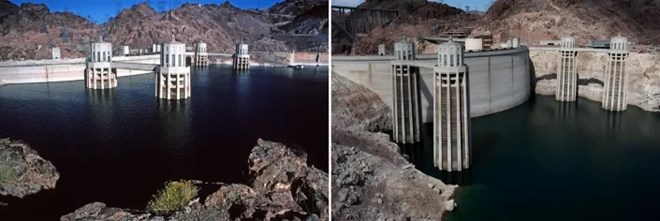
Water intake towers at the Hoover Dam in Las Vegas, on June 6, 1979, left, and on Aug. 19, 2022. (Santi Visalli; Justin Sullivan / Getty Images)
Lake Mead’s declining water levels also had unexpected consequences: In May, two sets of human remains were discovered as a result of the reservoir’s receding shoreline.